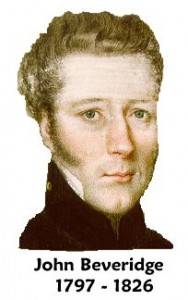| John Beveridge, born Dunfermline 1797, initially trained as a baker, following his father’s trade. (David Beveridge, who married Margaret Thomson, was a master baker in Guildhall Street, Dunfermline). John set up a bakery business in Ayr in 1818; however that enterprise failed and he became bankrupt. |
| Married second cousin At about the same time he married his second cousin Jane Guilliand, a disaster as it turned out. (He was 21; she 29). It appears he left her shortly after the marriage; there were no children. John then became a surgeon (an interesting change of profession), and after a false start in 1824, when he expected to ship as surgeon on a voyage to India, he was appointed Surgeon’s Mate on H.C.S. Royal George (Honourable [East India] Company Ship) in 1825, bound for Bengal and China. |
| £3.10.0 per month His pay was the princely sum of £3.10.0 per month, but he had “tonnage of 3 tons [hold space allocated to him] which he sold to the Captain for £120”. Whilst in Canton he had this miniature portrait painted – the original is about the size of a modern photograph. While there, the Royal George caught fire and sank, and John and some of the crew were repatriated home (in some comfort) as “shipwrecked sailors” aboard H.C.S. Bombay. |
| Bankruptcy of his patron On arrival at the Isle of Wight in June 1826, John was dismayed to read in the first newspaper he encountered, of the bankruptcy of his patron, a Mr William Brydon, London gentleman, with whom he had funds (a “bill”) deposited. However his money was safe, and with the profit from his voyage he paid off his creditors. |
| Died October 1826 Soon after his return, John took a Naval surgeon position in the Seamen’s’ Hospital Ship H.M.S. Grampus moored in the Thames at Deptford. Shortly after, he caught typhus whilst making a post-mortem, and died there in October 1826. Some of his effects, including a parcel of nine letters covering the period 1814 to 1826, his portrait, a large bible and a fine linen shirt, passed to his sister Elizabeth (Beveridge) Adamson. She brought them as part of her treasured family possessions, to Adelaide, South Australia, when she and husband James Adamson emigrated there in 1839. (They were my g-g-grandparents; he had a wheel wright business in Crossgates before emigration). |
| Head shaved…………..40 leeches applied From these letters, (plus two that remained in Scotland, copies of which I have been given by Christine Playfair of Dunfermline), I have been able to piece together this tale of a promising life cut short at 29. The last letter is from a relative at Deptford to the family in Dunfermline reporting the circumstances of John’s death. It gives a graphic description of early 19th century medicine. John was bled, his head shaved and kept wet with vinegar and water, 40 leeches were applied, and three blisters raised on his body, all to no avail! The original letters, portrait and shirt are in the care of Audrey Adamson of Adelaide, South Australia. I have transcribed the letters, and thank her for permission to reproduce the portrait. |
| India Called Them In his book “India Called Them”; Lord Beveridge wrote the following note on John Beveridge, his great-uncle, as he knew it from family tradition. “The black sheep of the family who, in his own way, paid all debts. Bankrupt as baker, qualified as surgeon, and from profits of East India voyage paid his creditors in full. Being held unwillingly to engagement with a [second] cousin, married her and left her at the church door. Ship’s surgeon on the ‘Royal George’ and ‘Grampus’. Died at 29 of typhus contracted in making a post- mortem.” |
| On and Off the Platform, Under the Southern Cross However after reading these letters whilst on a visit to Adelaide in 1948, Lord Beveridge revised his opinion of John. He wrote in a later book, “On and Off the Platform, Under the Southern Cross”: “John’s letters moreover show him, not a black sheep at all, but an engaging young man who made a young man’s mess of marriage – not leaving his bride at the church door as family tradition had it, but marrying at twenty the wrong person in obvious haste. One of the letters tells his sister of this marriage as of a bolt from the blue and puts a good face on it. ‘Let me repeat, I am perfectly happy.’ That is not the way in which a young man should write three days after marriage. And the wife does not appear again in any of his letters.”(Thanks to Robert M Adamson) |

